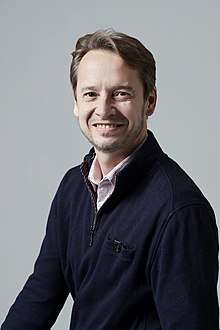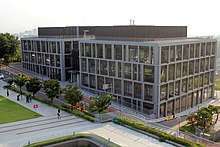Andreas J. Heinrich
Andreas J. Heinrich is a physicist working with scanning tunneling microscope, quantum technology, nanoscience, spin excitation spectroscopy, and precise atom manipulation. He worked for IBM Research in Almaden for 18 years, during which time he developed nanosecond scanning tunneling microscopy which provided an improvement in time resolution of 100,000 times,[1] and combined x-ray absorption spectroscopy with spin excitation spectroscopy.[2] He was also principal investigator of the stop-motion animated short film A Boy and His Atom filmed by moving thousands of individual atoms.[3] He serves on the Scientific Advisory Board of Max Planck Institute for Solid State Research[4] and is a fellow of the American Physical Society.
Andreas J. Heinrich | |
|---|---|
 | |
| Born | |
| Citizenship | Germany |
| Alma mater | University of Göttingen |
| Known for | Nanosecond scanning tunneling microscopy, spin excitation spectroscopy, precise atom manipulation, A Boy and His Atom |
| Awards | Heinrich Rohrer Medal (2020), Feynman Prize in Nanotechnology (2018), Joseph F. Keithley Award For Advances in Measurement Science (2018) |
| Scientific career | |
| Fields | Scanning tunneling microscope, quantum technology, nanoscience |
| Institutions | Center for Quantum Nanoscience, Institute for Basic Science Ewha Womans University IBM Research - Almaden |
| Website | IBS Center for Quantum Nanoscience |
In 2016, he became a distinguished professor at Ewha Womans University and the founding director of the Institute for Basic Science (IBS) Center for Quantum Nanoscience. Groundbreaking for the research center's Research Cooperation Building occurred in 2018 and was set to open in 2019[5][6] during the IBS Conference on Quantum Nanoscience.[7]
Education
He received his Masters (Diplom) and PhD in physics in 1994 and 1998, respectively, from the University of Göttingen, Germany. He was a research assistant from 1994 to 1998 under supervision of R. G. Ulbrich. After obtaining a PhD, he was a postdoc at IBM Almaden with Kavli Prize laureate Don Eigler until 2001, in which Heinrich was hired as a researcher/engineer.
Career
Desiring to leave Göttingen and with a goal to work in IBM's Almaden Research Center, he received a scholarship from the Alexander von Humboldt Foundation to finance his move. The German magazine Stern categorized Heinrich's move overseas as part of Germany's "brain drain".[8][9] After working in IBM Almaden for several years, he became a group leader on magnetic nanostructures on surfaces and scanning probe microscopy in 2005 where he worked until 2016. In 2012, he became a Fellow of the American Physics Society for the development of spin excitation spectroscopy and nanosecond STM. From 2012, he has been serving on the Scientific Advisory Board of Max Planck Institute for Solid State Research in Stuttgart, Germany.[4]
While exploring the limits of data storage, his team made A Boy and His Atom; the World's Smallest Stop-Motion Film as recognized by the Guinness Book of World Records.[10] Their research showed that data storage could shrink from a standard of one million atoms, down to twelve.[11] Less than five years later, the team Heinrich was on reduced this number to a single atom.[12] The Korean Ministry of Science and ICT deemed this research result one of the most substantial domestic outcomes of that year.[13][14][15]

He moved to South Korea to become a distinguished professor at Ewha Womans University and director of the Institute for Basic Science Center for Quantum Nanoscience in 2016. One of the long-term goals for the center is to fully control the quantum states of molecules and atoms on clean surfaces and near interfaces which would enable the use of high-sensitivity quantum sensors.[16][17] Working in collaboration with IBM Almaden, they were able to perform MRI scans on individual atoms.[18][19]
Honors and awards
- 2020: Heinrich Rohrer Medal[20]
- 2018: Outstanding National R&D Performances in 2018 (국가연구개발 우수성과 100선), Ministry of Science and ICT[13][14][15]
- 2018: Foresight Institute Feynman Prize in Nanotechnology[21][22][23]
- 2018: Joseph F. Keithley Award For Advances in Measurement Science[24][25]
- 2016: Distinguished Fellowship from the Chinese Academy of Sciences President's International Fellowship Initiative (PIFI)
- 2014: Outstanding Technical Achievement Award, IBM[26]
- 2012: Fellow of the American Physics Society
- 2011: Best of IBM Award
- 2011: Corporate Award, IBM
- 2010: Outstanding Technical Achievement Award, IBM
- 2007: Outstanding Innovation Award, IBM
- 2003: Research Division Award, IBM
- 1998: Feodor Lynen scholarship, Alexander von Humboldt Foundation, Germany
References
- Loth, Sebastian; Etzkorn, Markus; Lutz, Christopher P; Eigler, DM; Heinrich, Andreas J (24 September 2010). "Measurement of fast electron spin relaxation times with atomic resolution". Science. 329 (5999): 1628–1630. Bibcode:2010Sci...329.1628L. doi:10.1126/science.1191688. PMID 20929842.
- Rau, Ileana G; Baumann, Susanne; Rusponi, Stefano; Donati, Fabio; Stepanow, Sebastian; Gragnaniello, Luca; Dreiser, Jan; Piamonteze, Cinthia; Nolting, Frithjof; Gangopadhyay, Shruba; Macfarlane, Roger M; Lutz, Christopher P; Jones, Barbara A; Gambardella, Pietro; Heinrich, Andreas J; Brune, Harald (2014). "Reaching the magnetic anisotropy limit of a 3d metal atom". Science. 344 (6187): 988–992. Bibcode:2014Sci...344..988R. doi:10.1126/science.1252841. PMID 24812206.
- "IBM Research: A Boy And His Atom". IBM Research. Retrieved 17 May 2018.
- "Scientific Advisory Board". Max Planck Institute for Solid State Research. Retrieved 18 February 2019.
- "Center for Quantum Nanoscience Groundbreaking Ceremony at Ewha Womans University". Institute for Basic Science. 25 April 2018. Retrieved 16 May 2018.
The Center for Quantum Nanoscience at the Institute for Basic Science (Director Andreas Heinrich) will have a revolutionary new research space. The Research Collaboration Building (tentatively named) to be constructed by February 2019 at Ewha Womans University will be the new home of the Center.
- "QNS State-of-the-Art Research Facility". Center for Quantum Nanoscience. Archived from the original on 22 March 2019. Retrieved 16 May 2018.
- "Conference Schedule: QNS Dedication Ceremony". IBS Conference on Quantum Nanoscience. Center for Quantum Nanoscience. Retrieved 18 September 2019.
- "Die Besten hauen ab". Stern (magazine) (in German). Bertelsmann. 26 April 2004. Retrieved 19 September 2019.
- "Brain Drain". Center for Quantum Nanoscience. 17 July 2019. Retrieved 19 September 2019.
- "IBM Goes Atomic for Stop-Motion Film". Guinness World Records. 3 May 2013. Retrieved 17 May 2018.
- Moving Atoms: Making The World's Smallest Movie. IBM. 30 April 2013. Event occurs at 4:55. Retrieved 17 May 2018.
very recently what we have done, is we've been interested in the magnetic properties of atoms on surfaces. And really what we wanted to answer is a very simple question, how small can you make a magnet and still use it for data storage? We know we can make it stably out of a million atoms because that's what's done with current technologies, and we found that, for the materials that we chose, and were able to work with, only twelve atoms is sufficient.
- Natterer, Fabian D.; Yang, Kai; Paul, William; Willke, Philip; Choi, Taeyoung; Greber, Thomas; Heinrich, Andreas J.; Lutz, Christopher P. (8 March 2017). "Reading and Writing Single Atom Magnets". Nature. 543 (7644): 226–228. arXiv:1607.03977. Bibcode:2017Natur.543..226N. doi:10.1038/nature21371.
- "Andreas Heinrich Awarded Prize from the Minister of Science and ICT for the Smallest Memory Storage Unit in the World". Center for Quantum Nanoscience. 9 January 2019. Retrieved 18 February 2019.
- 김, 민아 (11 October 2018). "이화여대 연구자, 국가연구개발 우수성과 100선 선정". 천지일보. Retrieved 18 February 2019.
- "Three IBS Centers Listed on "Outstanding National R&D Performances in 2018"". Institute for Basic Science. 25 October 2018. Retrieved 18 February 2019.
- "Research Centers - Physics - Center for Quantum Nanoscience - About Center". Institute for Basic Science. Retrieved 18 May 2018.
- "2018 Joseph F. Keithley Award for Advances in Measurement Science Recipient". American Physical Society. Retrieved 16 May 2018.
for the design and construction of a series of highly sophisticated scanning probe instruments, including the development of inelastic electron tunneling spectroscopy at the single atom and single spin limit, that provided many breakthroughs in the science of measurement.
- Willke, Philip; Yang, Kai; Bae, Yujeong; Heinrich, Andreas J.; Lutz, Christopher P. (1 July 2019). "Magnetic resonance imaging of single atoms on a surface". Nature Physics. 15 (10): 1005–1010. arXiv:1807.08944. Bibcode:2019NatPh..15.1005W. doi:10.1038/s41567-019-0573-x.
- Sheikh, Knvul (1 July 2019). "Scientists Took an M.R.I. Scan of an Atom". The New York Times. Retrieved 5 July 2019.
- "The 3rd Heinrich Rohrer Medal". The Heinrich Rohrer Medal. The Japan Society of Vacuum and Surface Science. Retrieved 10 April 2020.
- "2018 Foresight Institute Feynman Prize". Foresight Institute. May 23, 2018. Retrieved 7 June 2018.
For advances in manipulating atoms and small molecules on surfaces and employing them for data storage and computation.
- "Andreas Heinrich Director of the Center for Quantum Nanoscience Awarded the 2018 Foresight Institute Feynman Prize in Nanotechnology for Experimental work". Institute for Basic Science. 11 May 2018. Retrieved 17 May 2018.
- 김, 태진 (11 May 2018). "IBS 하인리히 단장, 美 포어사이트 연구소 '2018 파인만 상' 수상". News1 Korea (in Korean). Retrieved 18 February 2019.
- "2018 Joseph F. Keithley Award for Advances in Measurement Science Recipient". American Physical Society. Retrieved 16 May 2018.
for the design and construction of a series of highly sophisticated scanning probe instruments, including the development of inelastic electron tunneling spectroscopy at the single atom and single spin limit, that provided many breakthroughs in the science of measurement.
- "Andreas Heinrich Received the "Joseph F. Keithley Award For Advances in Measurement Science" from the American Physical Society". Institute for Basic Science. 7 March 2018. Retrieved 17 May 2018.
- "Director Andreas Heinrich - Awards and Plenary Lectures". Center for Quantum Nanoscience. Institute for Basic Science. Archived from the original on 26 February 2020. Retrieved 18 May 2018.
External links
- Institute for Basic Science - Andreas J. Heinrich
- IBS Center for Quantum Nanoscience
- Andreas Heinrich - Google Scholar Citations
- Institute for Basic Science (IBS)
- YouTube channel - QNS Center for Quantum Nanoscience
- Exploring the Quantum World inside Atoms
- Nature Index - Center for Quantum Nanoscience